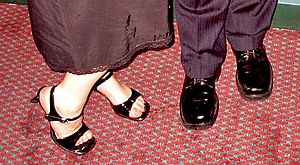 |
| English: (Photo credit: Wikipedia) |
Overlapping toes usually affects the fifth toe and it can occur prior to birth. A process of stretching and taping can be done during infancy, but the deformity usually returns. There is a surgical procedure where the tendon at the base of the small toe is released allowing the toe to assume a more normal position. On occasion a pin may have to be placed to keep the toe in alignment.
Underlapping toes affect the fourth and fifth toe and are probably caused by unequal strength in muscles. If underlapping toes are present at birth it is called congenital curly toes. This deformity can be corrected surgically with a couple of different procedures depending on whether the toes remain flexible or are rigid. Your foot and ankle specialist can best determine the procedure necessary in your situation.
In order to provide comfort to the patient, the first step in treatment is to change to footwear that will allow room for the deformity. Dr. Bowman may recommend orthotics designed to straighten and space the toes correctly. If this conservative treatment is not successful, a surgical procedure to release the tendon will allow the toe to reposition.
A recap of some of the treatment options include:
- Wide deep shoes to avoid pressure on the deformity
- Corn and callus treatment
- Orthotics to space and align toes
- Surgical treatment
If you have a bunion watch for symptoms of overlapping toes and call Dr. Bowman at (713) 467-8886. His expert ability to rearrange toe positioning can make your feet pretty again.
References:
http://www.houstonfootspecialists.com/library/1907/OverlappingorUnderlappingToes.html
http://www.prlog.org/10352809-overlapping-and-underlapping-toes.html




No comments:
Post a Comment